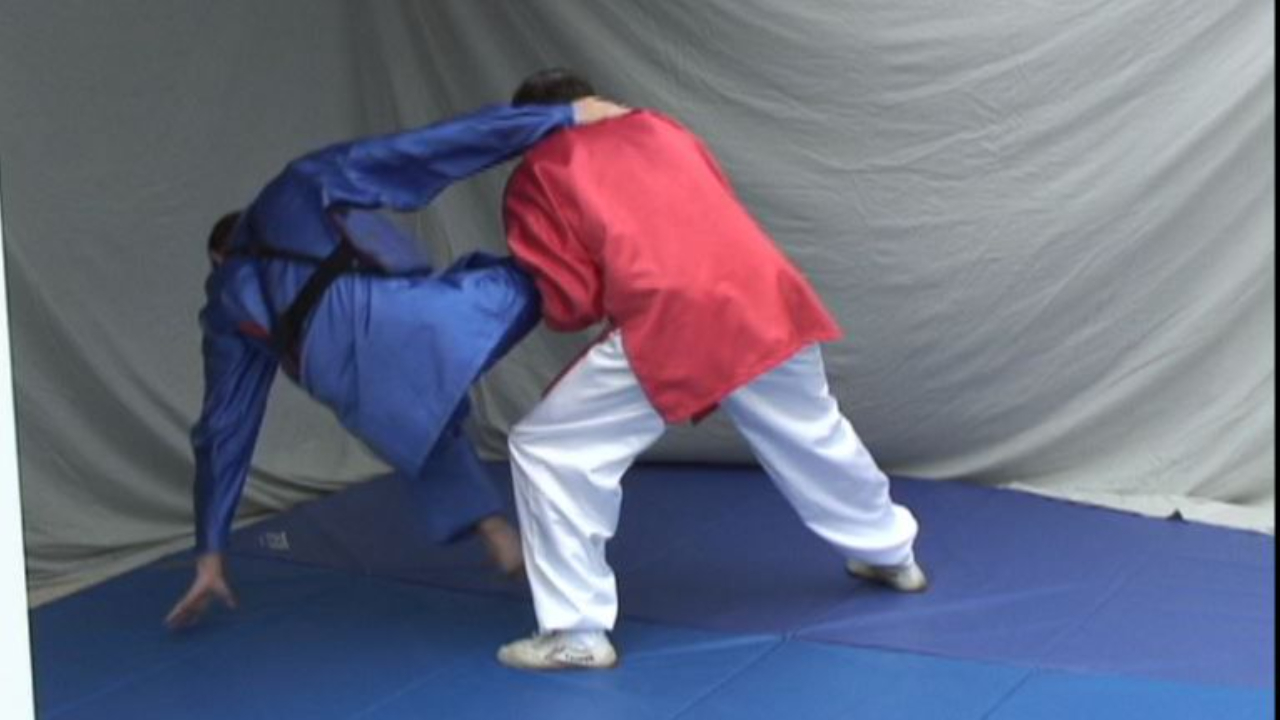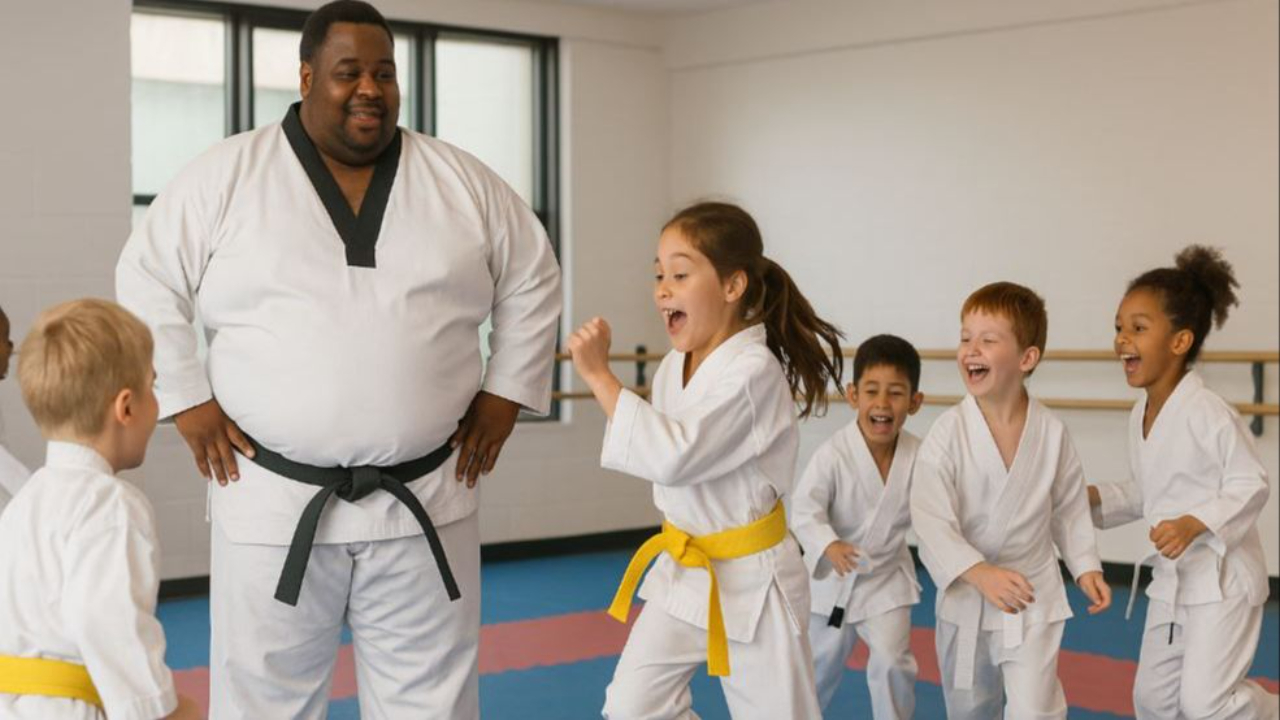The Perfect Image of Bagua Zhang - the Spinning Wire Ball

There are three images that summarize the three main internal arts. They are simple images and do not encompass all the subtleties but still represent good concepts.
You can think of Xingyi (Hsing-I) as a wedge driving through an opponent. A Xingyi fighter explodes through an opponent and takes his ground.
A Taiji fighter is like a beach ball being submerged into a swimming pool. The ball will take your
energy and give a bit, but there is strength underneath, and it will spring back and spin, dumping you into the water.
Bagua is like punching into a spinning wire ball. The ball catches your force and spins you off-balance, controlling your center and spinning you out in unexpected directions. It often leaves you broken by the time it spins you out.
Here is just one example. My opponent punches. I intercept the punch, wrapping my left arm
around his punching arm. At the same time, I begin spinning to his outside.
I hook his right arm and continue to spin. At this point, I ca...
What "Intent" Really Means in Taiji and the Internal Arts

I am currently updating my instructional videos for the Chen Tai Chi form Laojia Yilu, replacing video shot between 2008 and 2010. As I was shooting instruction on Sunday for the second movement of the form -- Buddha's Warrior Attendant Pounds Mortar -- the concept of "intent" came to mind as something a lot of people misunderstand.
A lot of Tai Chi instructors talk about "intent," but too many students are left with the impression that intent is somehow connected to "cultivating chi" or other mystical, healing energy nonsense.
Let's cut out the noise, eliminate the middleman, and cut to the chase.
"Intent" means exactly what it implies. What is the intent of the movement? What are you intending to do with this movement?
The answer is almost always a self-defense application.
Tai Chi was created as a martial art. Every movement in the form is a self-defense movement.
When you perform Tai Chi movements with the intent of self-defense, it informs how your "energy" should be use...
No Room for Fear -- What You Should Expect from Your Personal Philosophy

Caution: this post contains a very graphic photo below. If blood upsets you, don't scroll down.
I have spent five of the past six nights in the hospital, including two trips in an ambulance. I've had to postpone a podcast interview and a few gongfu practices.
It started when I was sitting in my home office and began coughing up blood. This went on for over half an hour. It stopped for half an hour and then began even harder. Nancy called 911 and the ambulance came.
By the time the coughing stopped, long after I arrived in the ER, about two pints of blood had come up from my lungs and out my mouth. At one point, it dawned on me that blood loss could cause me to pass out and there was a chance I wouldn't wake up. The ER at Illini Hospital couldn't help me, so after the bleeding stopped they sent me by ambulance 90 minutes away to Iowa City and the University of Iowa's Medical Intensive Care Unit.
They...
How to Use Tai Chi for Meditation - Moving Mindfulness

Tai Chi is a martial art, but in the past hundred or so years, the image of Tai Chi has become linked to the concept of "moving meditation," geared toward adults and seniors who want a relaxed way to exercise and improve their health, balance, flexibility, etc.
Those of us who see Tai Chi as a vigorous, athletic martial art are sometimes at odds with those who preach the art as something that will make you "One with the Universe" or will help you "cultivate chi."
I am a chi skeptic. I do not think chi is a scientific reality. After all these centuries, after scientific discoveries that include atoms and quarks and relativity, no one has ever been able to prove that chi is real.
But recently, interviews I have done for my Internal Fighting Arts podcast, and studying I have done on Mindfulness, made me realize there is a happy medium where focusing on the proper body mechanics when performing a Tai Chi form -- the body mechanics that make it martial -- can be combined with Mindfulnes...
Rules and Rituals in Martial Arts -- Is It Respect or Superstition?

I belonged to an internal arts school that had some rules that were carved in stone. Here are some of them:
**Each time you approach the training floor, you stop and bow to the floor. Each time you leave the floor, you bow to the floor before stepping off.
**Street shoes are NOT allowed on the training floor.
**At the beginning of each class, there is a moment of meditation and a bow to the shrine at the front of the room, designed to honor past masters.
**Only instructors are allowed to touch objects on the shrine.
**If you drop your sash to the floor, you must kiss both ends before putting it back on to show that you intend no disrespect to yourself.
**Men wear the knot on their sash on the right side and women wear it on the left. Once you reach Master level that reverses -- men wear the knot on the left side and women on the right.
**The sash is never washed because according to tradition, washing your sash will wash away your strength.
**When we perform techniques, we coun...
Internal Body Mechanics Come Together in Silk-Reeling Exercises

The body mechanics of real Tai Chi are very different than other "hard" martial arts that I had studied. I had been a student of Shaolin, Taekwondo, Wushu (Tien Shan Pai), and I had practiced karate on my own. I had also studied Xingyi, Bagua, and, as I mentioned above, Yang Tai Chi.
Nothing prepared me for the nuances and subtlety of Chen family Taijiquan. Over time, as I learned from Jim and Angela, the late Mark Wasson, and masters such as Chen Xiaowang, Chen Xiaoxing,
Ren Guangyi and others, I began to isolate six crucial body mechanics that yo...
A Beautiful Day and A Christmas Tree on a Baby's Grave


What a beautiful, sunny day it is today! It seems as if the sun has been hibernating behind the clouds for the past two or three weeks, but today, a few days after Christmas, it must have decided to get a little more shining done before the year is over.
It was such a nice day, despite being 28 degrees, Nancy and I took our little dog Minnie for a walk, and we headed down the street to a large, peaceful cemetery with a network of paved roads that serve as a walking path for the neighborhood.
At one point, Nancy noticed a small Christmas tree, about two or three feet tall, that someone had planted in the ground about 15 feet from the path. It was an unusual sight, so I walked across the grass to have a closer look.
The little Christmas tree had been put up next to the grave of a baby who had died just a few years ago.
I read the name on the stone and walked away, but a flood of emotion made me turn and go back, realizing the pain and the love the parents were trying to express dur...
How Commercial Should a Martial Arts Instructor Be?

I took my 11-year old granddaughter to her Taekwondo class last night. She has been studying at a "family" TKD school affiliated with the ATA. After a little more than a year, she earned her brown belt last weekend. The classes are a little different than when I studied Taekwondo back in the Seventies.
When I took my granddaughter to class a year ago, the classes were filled with children who were just beginning to learn. They were clumsy and uncertain, as most kids are when learning a new physical skill. It was interesting to me, after being involved in martial arts for 41 years, and having owned my own school, to watch the way the TKD teachers build in a lot of non-martial activities to keep children active and motivated. They really have it down.
A typical class might involve the following:
** Foot races up and down the floor near the beginning of class.
** 10 or 15 minutes of instruction into TKD technique.
** Instruction that is not very picky regarding perfection.
** The l...
New Internal Fighting Arts Podcast - Interview with Michael Chritton

I have launched a podcast on the Internal Fighting Arts. It is available on Apple Podcasts, Google Play, Spotify, and other podcast distributors.
Each episode will feature a talented English-speaking instructor of the internal arts -- Taiji, Xingyi, Bagua, Qigong, and we will also deal with the philosophy that guides these arts.
I am looking to interview top instructors who have ties to great masters. I want listeners to come away with something useful to help them in their internal arts journey.
I am fascinated by the people who have gone to great expense, great pains, and have travelled to seek out masters if Taiji, Xingyi, Bagua, and Qigong. I am also interested in the philosophical side of the internal arts, especially philosophical Taoism and Zen Buddhism.
My goal is to promote good teachers and help spread the internal arts of Chinese gongfu. As the name implies, my angle is the "Internal Fighting Arts." You might occasionally hear someone who takes a really "soft" approach ...
Taiji Grappling and Taking Advantage of Your Opponent's Energy

Anyone who reads this blog regularly knows that it is a mistake to interpret the term "energy" in some mystical way. Energy can simply mean "force" when discussing the energy an opponent is directing at you.
Energy can also mean "method" to describe a way of dealing with the force your opponent is directing your way. In other words, Cai Jin (Pluck Energy) describes a method of plucking or jerking to put your opponent off-balance. There is no actual "energy" called Cai in your body.
Many Westerners are inclined to believe things literally -- Adam and Eve, ghosts and psychics, etc. -- and so mythology has developed around the energy of the internal arts. You don't gain skill by increasing chi, your "chi" increases as you work like hell, gain experience, insight, and develop skill as you do in any sport, any physical endeavor, any trade or profession.
I love the grappling skills associated with the body mechanics of Taiji -- how to feel my partner's energy and take advantage of it to...
